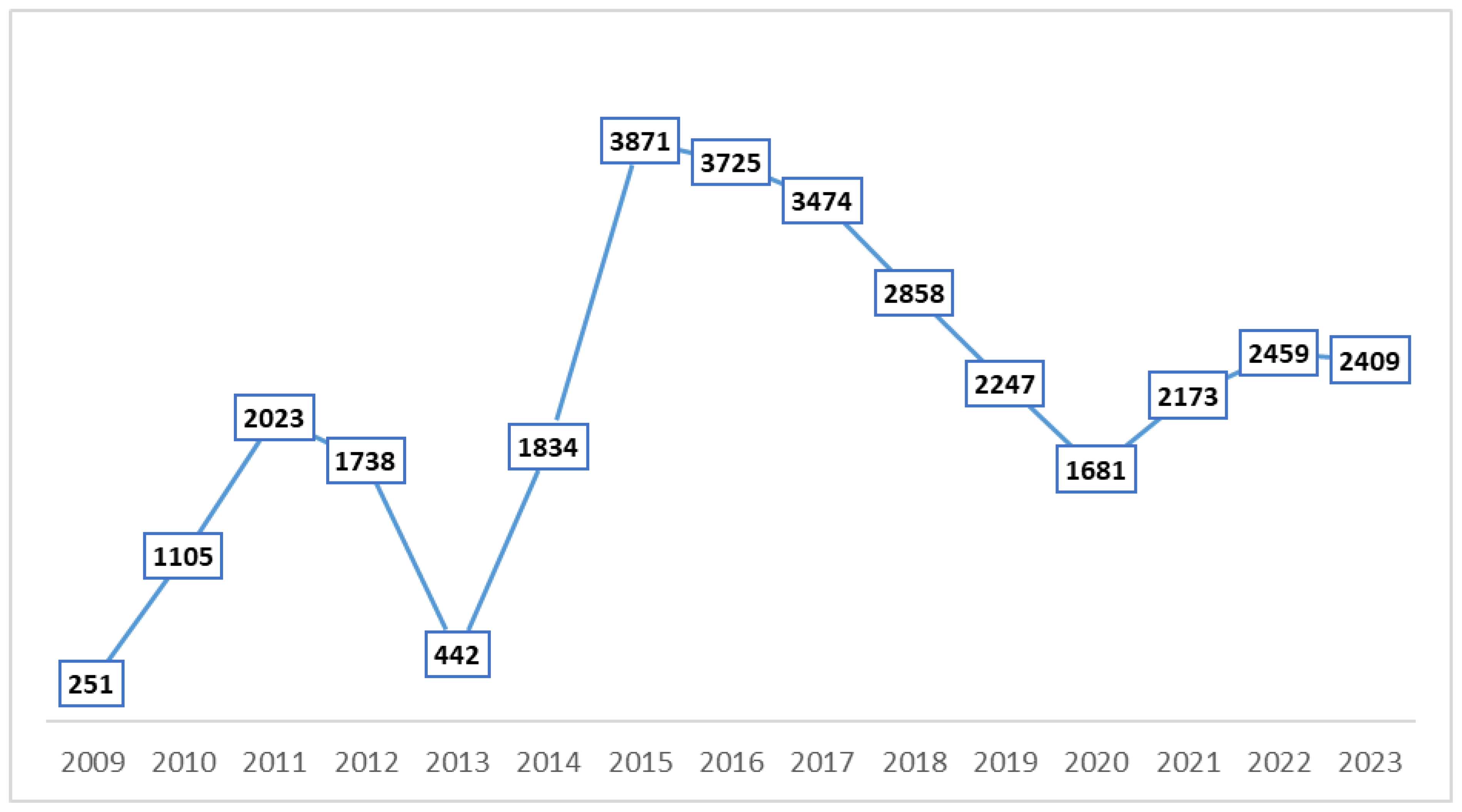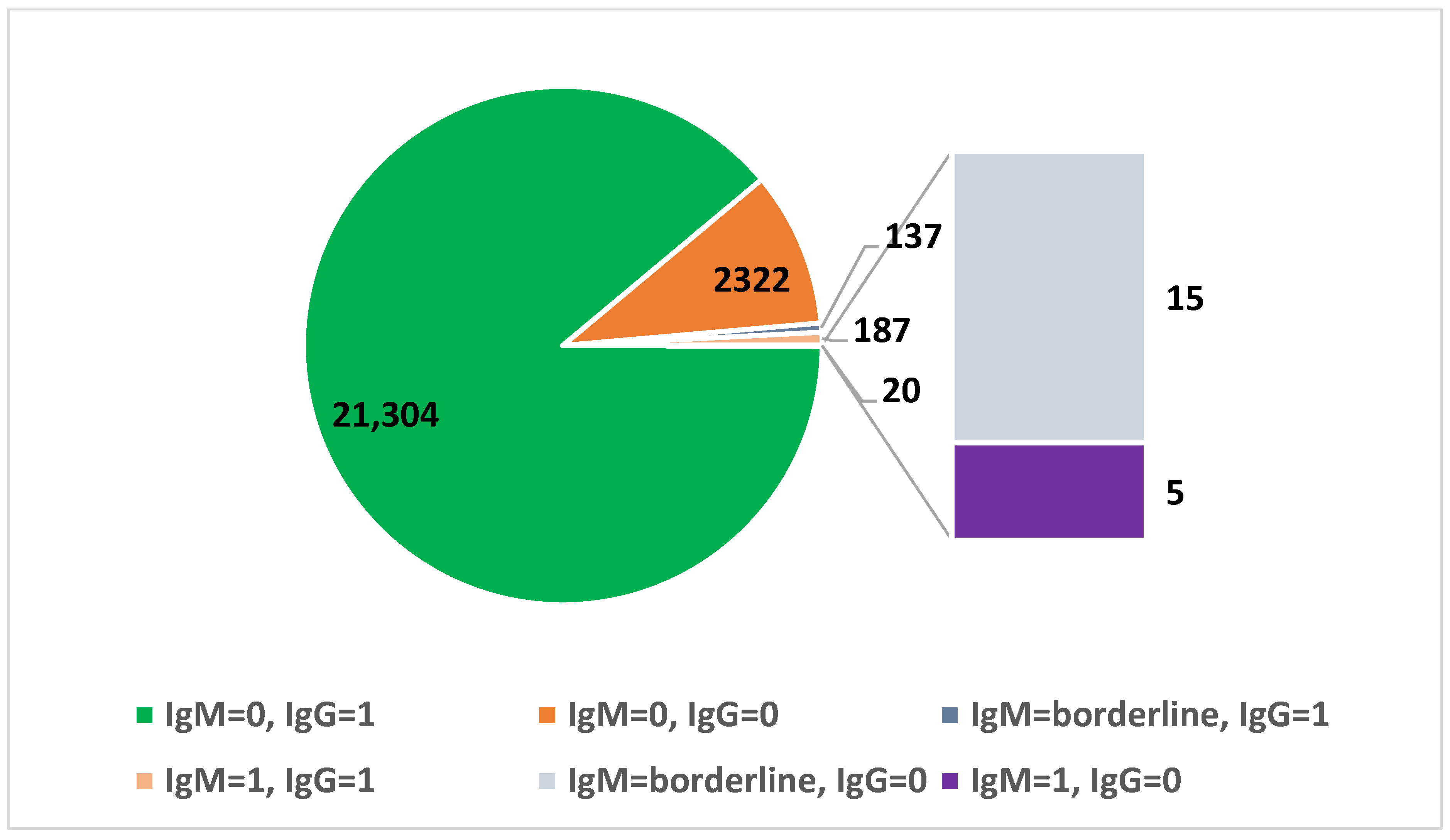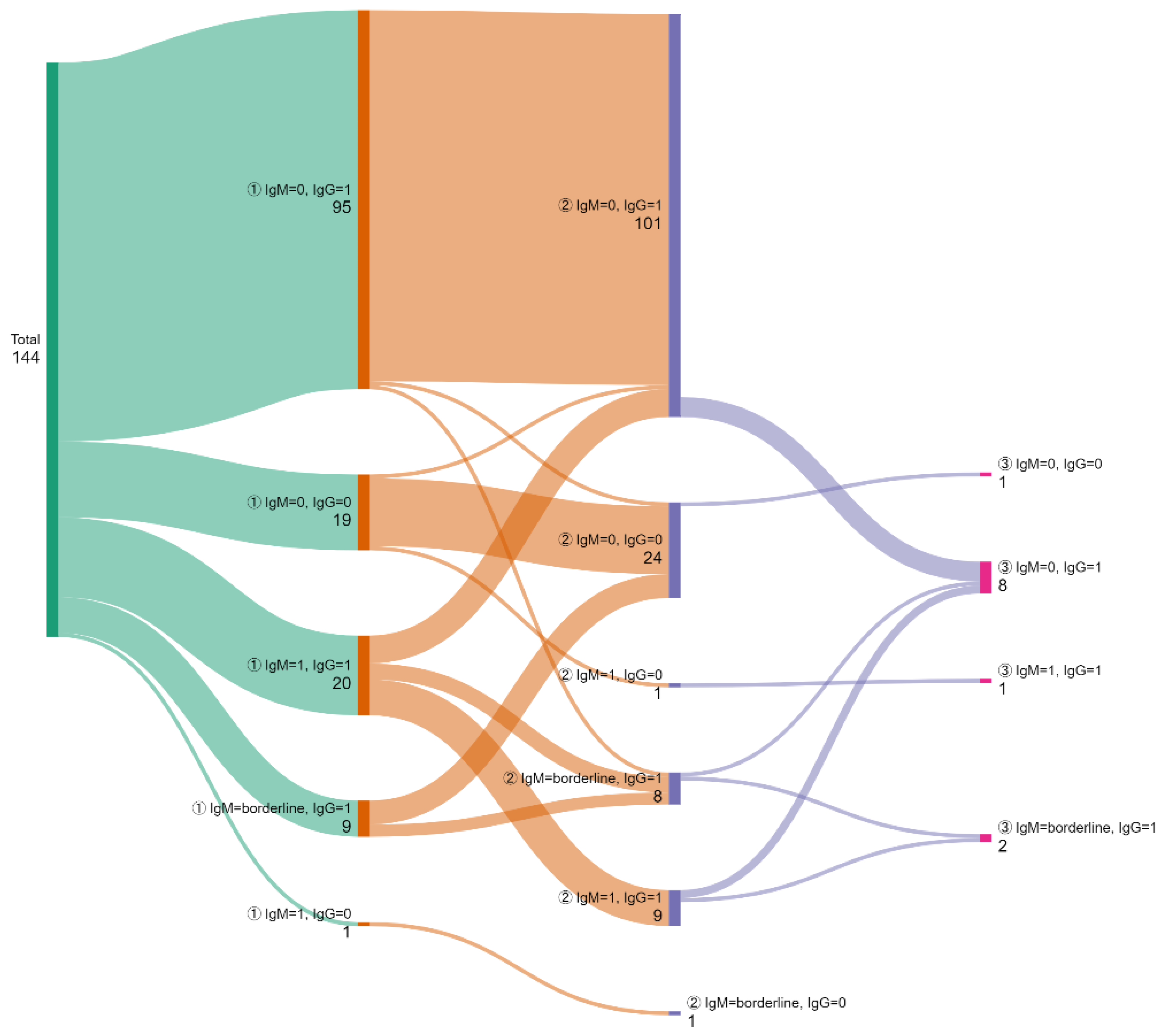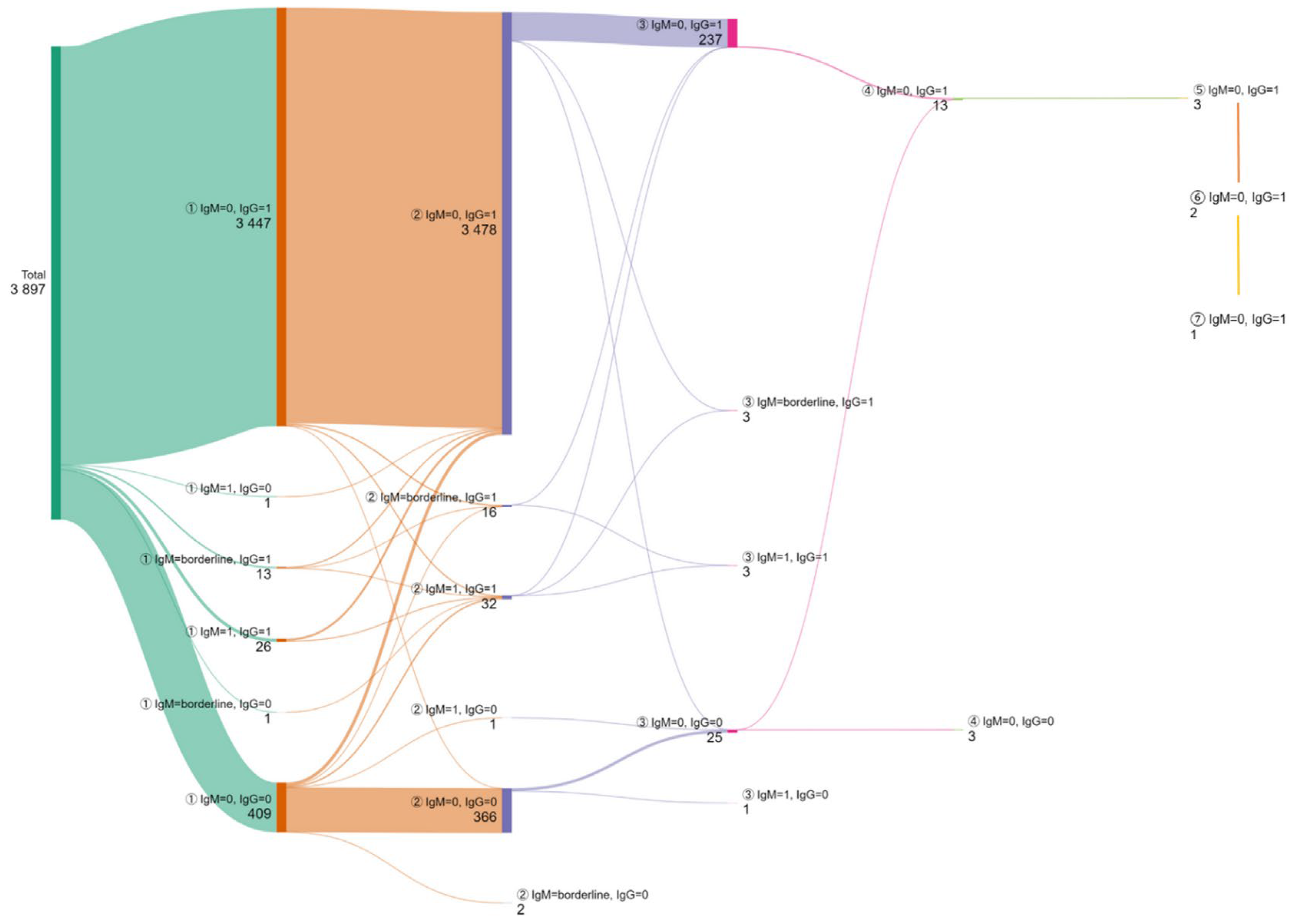Cytomegalovirus Infection Screening in Pregnant Women from Northwest Romania: Results of a 15-Year Follow-Up Program
Abstract
1. Introduction
- Seroconversion during pregnancy (negative/positive IgM and negative IgG in the first sample and positive IgM and IgG in the second at more than 2–3 weeks);
- IgG and IgM positive with low or intermediate IgG avidity;
- IgG-positive and IgM-negative;
- IgG- and IgM-positive with high IgG avidity index.
2. Materials and Methods
2.1. Study Design and Setting
2.2. Participants
2.3. Variables
2.4. Laboratory Assays
2.5. Statistical Analysis
3. Results
3.1. Index CMV Testing in Pregnant Women
3.2. Serological Profiles During the Same Pregnancy
3.3. Serological Profiles During Consecutive Pregnancies
4. Discussion
5. Strengths and Limitations
6. Conclusions
Author Contributions
Funding
Institutional Review Board Statement
Informed Consent Statement
Data Availability Statement
Conflicts of Interest
References
- Périllaud-Dubois, C.; Hachicha-Maalej, N.; Lepers, C.; Letamendia, E.; Teissier, N.; Cousien, A.; Sibiude, J.; Deuffic-Burban, S.; Vauloup-Fellous, C.; Picone, O. Cost-effectiveness of screening and valacyclovir-based treatment strategies for first-trimester cytomegalovirus primary infection in pregnant women in France. Ultrasound Obs. Gynecol. 2023, 62, 573–584. [Google Scholar] [CrossRef] [PubMed]
- Sanchez-Durán, M.A.; Maiz, N.; Liutsko, L.; Bielsa-Pascual, J.; García-Sierra, R.; Zientalska, A.M.; Velasco, I.; Vazquez, E.; Gracia, O.; Ribas, A.; et al. Universal screening programme for cytomegalovirus infection in the first trimester of pregnancy: Study protocol for an observational multicentre study in the area of Barcelona (CITEMB study). BMJ Open 2023, 13, e071997. [Google Scholar] [CrossRef] [PubMed]
- Pontes, K.F.M.; Nardozza, L.M.M.; Peixoto, A.B.; Werner, H.; Tonni, G.; Granese, R.; Araujo Júnior, E. Cytomegalovirus and Pregnancy: A Narrative Review. J. Clin. Med. 2024, 13, 640. [Google Scholar] [CrossRef] [PubMed]
- Ssentongo, P.; Hehnly, C.; Birungi, P.; Roach, M.A.; Spady, J.; Fronterre, C.; Wang, M.; Murray-Kolb, L.E.; Al-Shaar, L.; Chinchilli, V.M.; et al. Congenital Cytomegalovirus Infection Burden and Epidemiologic Risk Factors in Countries With Universal Screening: A Systematic Review and Meta-analysis. JAMA Netw. Open 2021, 4, e2120736. [Google Scholar] [CrossRef] [PubMed] [PubMed Central]
- Monteiro, S.; Gonçalves, A.; Torrão, M.M.; Costa, V.; Almeida, A. Knowledge of cytomegalovirus and available prevention strategies in pregnancy: A cross-sectional study in Portugal. J. Matern. Fetal Neonatal Med. 2023, 36, 2183754. [Google Scholar] [CrossRef]
- Chatzakis, C.; Ville, Y.; Makrydimas, G.; Dinas, K.; Zavlanos, A.; Sotiriadis, A. Timing of primary maternal cytomegalovirus infection and rates of vertical transmission and fetal consequences. Am. J. Obstet. Gynecol. 2020, 223, 870–883.e11. [Google Scholar] [CrossRef] [PubMed]
- Buca, D.; Di Mascio, D.; Rizzo, G.; Giancotti, A.; D’Amico, A.; Leombroni, M.; Makatsarya, A.; Familiari, A.; Liberati, M.; Nappi, L.; et al. Outcome of fetuses with congenital cytomegalovirus infection and normal ultrasound at diagnosis: Systematic review and meta-analysis. Ultrasound Obs. Gynecol. 2021, 57, 551–559. [Google Scholar] [CrossRef]
- Rybak-Krzyszkowska, M.; Górecka, J.; Huras, H.; Massalska-Wolska, M.; Staśkiewicz, M.; Gach, A.; Kondracka, A.; Staniczek, J.; Górczewski, W.; Borowski, D.; et al. Cytomegalovirus Infection in Pregnancy Prevention and Treatment Options: A Systematic Review and Meta-Analysis. Viruses 2023, 15, 2142. [Google Scholar] [CrossRef] [PubMed] [PubMed Central]
- Revello, M.G.; Tibaldi, C.; Masuelli, G.; Frisina, V.; Sacchi, A.; Furione, M.; Arossa, A.; Spinillo, A.; Klersy, C.; Ceccarelli, M.; et al. Prevention of primary cytomegalovirus infection in pregnancy. EBioMedicine 2015, 2, 1205–1210. [Google Scholar] [CrossRef]
- Korver, A.M.; de Vries, J.J.; de Jong, J.W.; Dekker, F.W.; Vossen, A.C.; Oudesluys-Murphy, A.M. Awareness of congenital cytomegalovirus among doctors in the Netherlands. J. Clin. Virol. 2009, 46 (Suppl. S4), S11–S15. [Google Scholar] [CrossRef] [PubMed]
- Goderis, J.; De Leenheer, E.; Smets, K.; Van Hoecke, H.; Keymeulen, A.; Dhooge, I. Hearing loss and congenital CMV infection: A systematic review. Pediatrics 2014, 134, 972–982. [Google Scholar] [CrossRef] [PubMed]
- Avettand-Fenoel, V.; Magny, J.F.; Ville, Y.; Leruez-Ville, M. Utilisation des tests virologiques pour le diagnostic, le pronostic et la surveillance des infections congénitales à cytomégalovirus [Virological tools for the diagnosis, the prognosis and the surveillance of congenital cytomegalovirus infections]. Arch. Pediatr. 2013, 20, 204–208. [Google Scholar] [CrossRef] [PubMed]
- Salomè, S.; Corrado, F.R.; Mazzarelli, L.L.; Maruotti, G.M.; Capasso, L.; Blazquez-Gamero, D.; Raimondi, F. Congenital cytomegalovirus infection: The state of the art and future perspectives. Front. Pediatr. 2023, 11, 1276912. [Google Scholar] [CrossRef] [PubMed]
- Razonable, R.R.; Humar, A. Cytomegalovirus in solid organ transplant recipients-Guidelines of the American Society of Transplantation Infectious Diseases Community of Practice. Clin. Transplant. 2019, 33, e13512. [Google Scholar] [CrossRef] [PubMed]
- Davis, N.L.; King, C.C.; Kourtis, A.P. Cytomegalovirus infection in pregnancy. Birth Defects Res. 2017, 109, 336–346. [Google Scholar] [CrossRef]
- Alford, C.A.; Stagno, S.; Pass, R.F.; Britt, W.J. Congenital and perinatal cytomegalovirus infections. Rev. Infect. Dis. 1990, 12 (Suppl. S7), S745–S753. [Google Scholar] [CrossRef]
- Zuhair, M.; Smit, G.S.A.; Wallis, G.; Jabbar, F.; Smith, C.; Devleesschauwer, B.; Griffiths, P. Estimation of the worldwide Seroprevalence of cytomegalovirus: A systematic review and meta-analysis. Rev. Med. Virol. 2019, 29, e2034. [Google Scholar] [CrossRef]
- Leruez-Ville, M.; Foulon, I.; Pass, R.; Ville, Y. Cytomegalovirus infection during pregnancy: State of the science. Am. J. Obstet. Gynecol. 2020, 223, 330–349. [Google Scholar] [CrossRef]
- Choodinatha, H.K.; Jeon, M.R.; Choi, B.Y.; Lee, K.N.; Kim, H.J.; Park, J.Y. Cytomegalovirus infection during pregnancy. Obstet. Gynecol. Sci. 2023, 6, 463–476. [Google Scholar] [CrossRef] [PubMed] [PubMed Central]
- Venturini, C.; Breuer, J. Cytomegalovirus Genetic Diversity and Evolution: Insights into Genotypes and Their Role in Viral Pathogenesis. Pathogens 2025, 14, 50. [Google Scholar] [CrossRef]
- Xie, M.; Tripathi, T.; Holmes, N.E.; Hui, L. Serological screening for cytomegalovirus during pregnancy: A systematic review of clinical practice guidelines and consensus statements. Prenat. Diagn. 2023, 43, 959–967. [Google Scholar] [CrossRef] [PubMed]
- Kenneson, A.; Cannon, M.J. Review and meta-analysis of the epidemiology of congenital cytomegalovirus (CMV) infection. Rev. Med. Virol. 2007, 17, 253–276. [Google Scholar] [CrossRef] [PubMed]
- Harmon, C.M.; Cooling, L.L. Current strategies and future directions for the prevention of transfusion-transmitted cytomegalovirus. Int. J. Clin. Transfus. Med. 2017, 5, 49–59. [Google Scholar] [CrossRef][Green Version]
- Balegamire, S.J.; McClymont, E.; Croteau, A.; Dodin, P.; Gantt, S.; Besharati, A.A.; Renaud, C.; Mâsse, B.; Boucoiran, I. Prevalence, incidence, and risk factors associated with cytomegalovirus infection in healthcare and childcare worker: A systematic review and meta-analysis. Syst. Rev. 2022, 11, 131. [Google Scholar] [CrossRef] [PubMed] [PubMed Central]
- Adler, S.P. Screening for Cytomegalovirus during Pregnancy. Infect. Dis. Obstet. Gynecol. 2011, 2011, 942937. [Google Scholar] [CrossRef]
- Khalil, A.; Heath, P.T.; Jones, C.E.; Soe, A.; Ville, Y.G. Royal College of Obstetricians Gynaecologists Congenital Cytomegalovirus Infection: Update on Screening Diagnosis Treatment: Scientific Impact Paper No 56. BJOG 2025, 132, e42–e52. [Google Scholar] [CrossRef] [PubMed]
- Permar, S.R.; Schleiss, M.R.; Plotkin, S.A. A vaccine against cytomegalovirus: How close are we? J. Clin. Investig. 2025, 135, e182317. [Google Scholar] [CrossRef] [PubMed] [PubMed Central]
- Zammarchi, L.; Tomasoni, L.R.; Liuzzi, G.; Simonazzi, G.; Dionisi, C.; Mazzarelli, L.L.; Seidenari, A.; Maruotti, G.M.; Ornaghi, S.; Castelli, F.; et al. MEGAL-ITALIWorking Group Treatment with valacyclovir during pregnancy for prevention of congenital cytomegalovirus infection: A real-life multicenter Italian observational study. Am. Jobstet. Gynecol. MFM 2023, 5, 101101. [Google Scholar] [CrossRef]
- Faas, B.H.W.; Astuti, G.; Melchers, W.J.G.; Reuss, A.; Gilissen, C.; Macville, M.V.E.; Ghesquiere, S.A.I.; Houben, L.M.H.; Srebniak, M.I.; Geeven, G.; et al. Early detection of active Human CytomegaloVirus (hCMV) infection in pregnant women using data generated for noninvasive fetal aneuploidy testing. EBioMedicine 2024, 100, 104983. [Google Scholar] [CrossRef]
- Maltezou, P.G.; Kourlaba, G.; Kourkouni, Ε.; Luck, S.; Blázquez-Gamero, D.; Ville, Y.; Lilleri, D.; Dimopoulou, D.; Karalexi, M.; Papaevangelou, V. Maternal type of CMV infection and sequelae in infants with congenital CMV: Systematic review and meta-analysis. J. Clin. Virol. 2020, 129, 104518. [Google Scholar] [CrossRef] [PubMed]
- Hui, L.; Shand, A. Is it time to adopt routine cytomegalovirus screening in pregnancy? No. Am. J. Obstet. Gynecol. MFM 2021, 3, 100355. [Google Scholar] [CrossRef]
- Enders, G.; Daiminger, A.; Bäder, U.; Exler, S.; Enders, M. Intrauterine transmission and clinical outcome of 248 pregnancies with primary cytomegalovirus infection in relation to gestational age. J. Clin. Virol. 2011, 52, 244–246. [Google Scholar] [CrossRef] [PubMed]
- Department of Health. Clinical Practice Guidelines: Pregnancy Care; Australian Government Department of Health: Canberra, Australia, 2020.
- Royal Australian and New Zealand College of Obstetricians and Gynaecologists. Prevention of Congenital Cytomegalovirus (CMV) Infection [Internet]; Royal Australian and New Zealand College of Obstetricians and Gynaecologists: Melbourne, Australia, 2019; Available online: https://ranzcog.edu.au/wp-content/uploads/Prevention-CMV-Infection.pdf (accessed on 16 May 2022).
- Gyselaers, W.; Jonckheer, P.; Ahmadzai, N.; Ansari, M.T.; Carville, S.; Dworzynski, K.; Gaudet, L.; Glen, J.; Jones, K.; Miller, P.; et al. What Are the Recommended Clinical Assessment and Screening Tests during Pregnancy? Good Clinical Practice (GCP); Belgian Health Care Knowledge Centre (KCE): Brussels, Belgium, 2015. [Google Scholar]
- Boucoiran, I.; Yudin, M.; Poliquin, V.; Caddy, S.; Gantt, S.; Castillo, E. Guideline no. 420: Cytomegalovirus infection in pregnancy. J. Obstet. Gynaecol. Can. 2021, 43, 893–908. [Google Scholar] [CrossRef] [PubMed]
- Congenital Cytomegalovirus Clinical Practice Guideline [Internet]; King Edward Memorial Hospital Obstetrics & Gynaecology: Subiaco, Australia. 2015. Available online: https://onlinelibrary.wiley.com/doi/pdf/10.1111/jpc.15946 (accessed on 16 May 2022).
- Siennicka, J.; Dunal-Szcepaniak, M.; Trzcińska, A.; Godzik, P.; Rosińska, M. High Seroprevalence of CMV Among Women of Childbearing Age Implicates High Burden of Congenital Cytomegalovirus Infection in Poland. Pol. J. Microbiol. 2017, 65, 425–432. [Google Scholar] [CrossRef] [PubMed]
- Radoi, C.L.; Zlatian, O.; Balasoiu, M.; Dragomir, T.L.; Sorop, M.I.; Bagiu, I.C.; Boeriu, E.; Susan, M.; Sorop, B.; Oprisoni, L.A.; et al. Seroprevalence of Anti-Cytomegalovirus Antibodies in Pregnant Women from South-West Romania. Microorganisms 2024, 12, 268. [Google Scholar] [CrossRef] [PubMed] [PubMed Central]
- Gorun, F.; Motoi, S.; Malita, D.; Navolan, D.B.; Nemescu, D.; Olariu, T.R.; Craina, M.; Vilibic-Cavlek, T.; Ciohat, I.; Boda, D.; et al. Cytomegalovirus seroprevalence in pregnant women in the western region of Romania: A large-scale study. Exp. Ther. Med. 2020, 20, 2439–2443. [Google Scholar] [CrossRef] [PubMed] [PubMed Central]
- Briciu, V.; Ionica, A.M.; Flonta, M.; Almas, A.; Muntean, M.; Topan, A.; Horvat, M.; Ungureanu, L.; Lupse, M. Toxoplasmosis Screening during Pregnancy in a Romanian Infectious Diseases Tertiary Center: Results of a 15 Years Follow-Up Program. Microorganisms 2023, 11, 2189. [Google Scholar] [CrossRef]
- Protocol Regarding the Methodology of Prenatal and Postnatal Consultations Documented in the Pregnant Woman’s Card. Available online: https://legislatie.just.ro/Public/DetaliiDocumentAfis/246408 (accessed on 25 April 2024). (In Romanian).
- Mocanu, A.G.; Gorun, F.; Ciohat, I.; Navolan, D.; Malita, D.; Vilibic-Cavlek, T.; Dahma, G.; Neamtu, R.; Popescu, D.; Cioca, A.; et al. Simultaneous Seroprevalence to Toxoplasma gondii, Cytomegalovirus and Rubella Virus in Childbearing Women from Western Romania. Medicina 2021, 57, 927. [Google Scholar] [CrossRef] [PubMed] [PubMed Central]
- Antona, D.; Lepoutre, A.; Fonteneau, L.; Baudon, C.; Halftermeyer-Zhou, F.; LEStrat, Y.; Lévy-Bruhl, D. Seroprevalence of cytomegalovirus infection in France in 2010. Epidemiol. Infect. 2017, 145, 1471–1478. [Google Scholar] [CrossRef] [PubMed] [PubMed Central]
- Barlinn, R.; Dudman, S.G.; Rollag, H.; Trogstad, L.; Lindstrøm, J.C.; Magnus, P. Maternal cytomegalovirus infection and delayed language development in children at 3 years of age-a nested case-control study in a large population-based pregnancy cohort. PLoS ONE 2022, 17, e0278623. [Google Scholar] [CrossRef] [PubMed] [PubMed Central]
- D’Antonio, F.; Marinceu, D.; Prasad, S.; Khalil, A. Effectiveness and safety of prenatal valacyclovir for congenital cytomegalovirus infection: Systematic review and meta-analysis. Ultrasound Obs. Gynecol. 2023, 61, 436–444. [Google Scholar] [CrossRef] [PubMed]
- Shahar-Nissan, K.; Pardo, J.; Peled, O.; Krause, I.; Bilavsky, E.; Wiznitzer, A.; Hadar, E.; Amir, J. Valaciclovir to prevent vertical transmission of cytomegalovirus after maternal primary infection during pregnancy: A randomised, double-blind, placebo-controlled trial. Lancet 2020, 396, 779–785. [Google Scholar] [CrossRef] [PubMed]
- Razonable, R.R.; Inoue, N.; Pinninti, S.G.; Boppana, S.B.; Lazzarotto, T.; Gabrielli, L.; Simonazzi Pellett, P.E.; Schmid, D.S. Clinical Diagnostic Testing for Human Cytomegalovirus Infections. J. Infect. Dis. 2020, 221 (Suppl. S1), S74–S85. [Google Scholar] [CrossRef]
- Barber, V.; Calvert, A.; Vandrevala, T.; Star, C.; Khalil, A.; Griffiths, P.; Heath, P.T.; Jones, C.E. Prevention of Acquisition of Cytomegalovirus Infection in Pregnancy Through Hygiene-based Behavioral Interventions: A Systematic Review and Gap Analysis. Pediatr. Infect. Dis, J. 2020, 39, 949–954. [Google Scholar] [CrossRef] [PubMed]
- Rodríguez-Muñoz, M.F.; Martín-Martín, C.; Kovacheva, K.; Olivares, M.E.; Izquierdo, N.; Pérez-Romero, P.; García-Ríos, E. Hygiene-based measures for the prevention of cytomegalovirus infection in pregnant women: A systematic review. BMC Pregnancy Childbirth 2024, 24, 172. [Google Scholar] [CrossRef] [PubMed] [PubMed Central]
- Calvert, A.; Vandrevala, T.; Parsons, R.; Barber, V.; Book, A.; Book, G.; Carrington, D.; Greening, V.; Griffiths, P.; Hake, D.; et al. Changing knowledge, attitudes and behaviours towards cytomegalovirus in pregnancy through film-based antenatal education: A feasibility randomised controlled trial of a digital educational intervention. BMC Pregnancy Childbirth 2021, 21, 565. [Google Scholar] [CrossRef] [PubMed] [PubMed Central]
- Sankey MATIC. Available online: https://sankeymatic.com (accessed on 16 July 2023).
- Mocanu, A.G.; Stoian, D.L.; Daescu, A.C.; Motofelea, A.C.; Ciohat, I.M.; Navolan, D.B.; Vilibic-Cavlek, T.; Bogdanic, M.; Nemescu, D.; Tomescu, L.; et al. The Impact of Latent Cytomegalovirus Infection on Spontaneous Abortion History and Pregnancy Outcomes in Romanian Pregnant Women. Microorganisms 2024, 12, 731. [Google Scholar] [CrossRef] [PubMed] [PubMed Central]
- Mussi-Pinhata, M.M.; Yamamoto, A.Y.; Aragon, D.C.; Duarte, G.; Fowler, K.B.; Boppana, S.; Britt, W.J. Seroconversion for Cytomegalovirus Infection During Pregnancy and Fetal Infection in a Highly Seropositive Population: “The BraCHS Study”. J. Infect. Dis. 2018, 218, 1200–1204. [Google Scholar] [CrossRef]
- Izquierdo, G.; Sandoval, A.; Abarzúa, F.; Yamamoto, M.; Rodríguez, J.G.; Silva, M.; Torres, J.P.; Aravena, M.; Fuentes, D.; Reyes, A.; et al. Recomendaciones para el diagnóstico y manejo de la infección por citomegalovirus en la mujer embarazada y el recién nacido. Rev. Chil. Infectol. 2021, 38, 824–856. [Google Scholar] [CrossRef]
- Hadjiiona, A.; Michaelides, I.; Kummer, P.; Kappelmeyer, M.; Koeninger, A.; Reuschel, E. Frequency of CMV testing during pregnancy-a retrospective study. Arch. Gynecol. Obstet. 2025, 311, 1297–1304. [Google Scholar] [CrossRef]
- Enders, G.; Daiminger, A.; Lindemann, L.; Knotek, F.; Bäder, U.; Exler, S.; Enders, M. Cytomegalovirus (CMV) seroprevalence in pregnant women, bone marrow donors and adolescents in Germany, 1996–2010. Med. Microbiol. Immunol. 2012, 201, 303–309. [Google Scholar] [CrossRef] [PubMed]
- Greye, H.; Wex, T.; Taneva, E.; Redlich, A.; Costa, S.-D.; Rissmann, A. Cytomegalovirus seronegativity rate in pregnant women and primary cytomegalovirus infection during pregnancy in rural Germany. BMC Pregnancy Childbirth 2023, 23, 299. [Google Scholar] [CrossRef] [PubMed]
- De Vries, J.J.; van Zwet, E.W.; Dekker, F.W.; Kroes, A.C.; Verkerk, P.H.; Vossen, A.C. The apparent paradox of maternal seropositivity as a risk factor for congenital cytomegalovirus infection: A population-based prediction model. Rev. Med. Virol. 2013, 23, 241–249. [Google Scholar] [CrossRef] [PubMed]
- Billette de Villemeur, A.; Hoen, B.; Billaud, E.; Deruelle, P.; Goueslard, K.; Halley des Fontaines, V.; Minodier, P.; Parent, B.; Pozzetto, B.; Revest, M.; et al. Current evidence gaps to support systematic cytomegalovirus screening in pregnancy. eClinicalMedicine 2024, 78, 102941. [Google Scholar] [CrossRef]
- Bartnik, P.; Bender, A.; Kacperczyk-Bartnik, J.; Ciebiera, M.; Urban, A.; Sienko, A.; Bilir, E.; Romejko-Wolniewicz, E.; Sieńko, J. Awareness of Pregnant Patients about Congenital Cytomegalovirus Infection—A Semi-Systematic Review. J. Clin. Med. 2024, 13, 2586. [Google Scholar] [CrossRef]
- Greye, H.; Henning, S.; Freese, K.; Köhn, A.; Lux, A.; Radusch, A.; Redlich, A.; Schleef, D.; Seeger, S.; Thäle, V.; et al. Cross-sectional study to assess awareness of cytomegalovirus infection among pregnant women in Germany. BMC Pregnancy Childbirth 2022, 22, 964. [Google Scholar] [CrossRef]
- Boppana, S.B.; Rivera, L.B.; Fowler, K.B.; Mach, M.; Britt, W.J. Intrauterine transmission of cytomegalovirus to infants of women with preconceptional immunity. N. Engl. J. Med. 2001, 344, 1366–1371. [Google Scholar] [CrossRef] [PubMed]
- Leruez-Ville, M.; Chatzakis, C.; Lilleri, D.; Blazquez-Gamero, D.; Alarcon, A.; Bourgon, N.; Foulon, I.; Fourgeaud, J.; Gonce, A.; Jones, C.E.; et al. Consensus recommendation for prenatal, neonatal and postnatal management of congenital cytomegalovirus infection from the European congenital infection initiative (ECCI). Lancet Reg. Health Eur. 2024, 40, 100892. [Google Scholar] [CrossRef]
- Linthorst, J.; Baksi, M.M.M.; Welkers, M.R.A.; Sistermans, E.A. The cell-free DNA virome of 108,349 Dutch pregnant women. Prenat. Diagn. 2023, 43, 448–456. [Google Scholar] [CrossRef] [PubMed]




| Age | Mean (min-max) ± SDEV | 29.44 (12–54) ± 4.96 |
| Median | 29 | |
| County | Cluj County | 23,889 (85.28%; 95% CI: 84.86–85.69) |
| Other counties | 4123 (14.72%; 95% CI: 14.31–15.14) | |
| Residence | Urban | 19,474 (69.52%; 95% CI: 68.98–70.06) |
| Rural | 8538 (30.48%; 95% CI: 29.94–31.02) |
| Age Group | n | % | IgM | IgG | ||||
|---|---|---|---|---|---|---|---|---|
| + | % | 95% CI | + | % | 95% CI | |||
| [12–14.9] | 14 | 0.04 | 0 | 0.00 | 0.00–33.67 | 14 | 100.00 | 76.84–100.00 |
| [15–19.9] | 587 | 1.82 | 7 | 1.19 | 0.58–2.44 | 540 | 91.99 | 89.51–93.93 |
| [20–24.9] | 3766 | 11.66 | 36 | 0.96 | 0.69–1.32 | 3399 | 90.25 | 89.27–91.16 |
| [25–29.9] | 11,816 | 36.59 | 98 | 0.83 | 0.68–1.01 | 10,558 | 89.35 | 88.78–89.9 |
| [30–34.9] | 10,759 | 33.32 | 102 | 0.95 | 0.78–1.15 | 9701 | 90.17 | 89.59–90.71 |
| [35–39.9] | 4499 | 13.93 | 36 | 0.80 | 0.58–1.11 | 4115 | 91.46 | 90.61–92.25 |
| [40–44.9] | 812 | 2.51 | 3 | 0.37 | 0.13–1.08 | 747 | 92.00 | 89.92–93.67 |
| [45–49.9] | 35 | 0.11 | 0 | 0.00 | 0.00–10.00 | 34 | 97.14 | 85.08–99.93 |
| [50+] | 2 | 0.01 | 0 | 0.00 | 0.00–84.19 | 2 | 100.00 | 15.81–100.00 |
| TOTAL | 32,290 | 282 | 0.87 | 0.78–0.98 | 29,110 | 90.15 | 89.82–90.47 | |
| Period | Positive Tests | Positive Women | ||||||
| n | % | 95% CI | χ2 = 17.8 df. = 2 p = 0.0001 | n | % | 95% CI | χ2 = 19.48 df. = 2 p = 0.0001 | |
| I (2009–2013) | 5063 | 91.08 | 90.30–91.80 | 4846 | 91.00 | 90.21–91.74 | ||
| II (2014–2018) | 14,260 | 90.47 | 90.00–90.92 | 12,408 | 90.48 | 89.97–90.96 | ||
| III (2019–2023) | 9787 | 89.22 | 88.63–89.79 | 7985 | 88.99 | 88.32–89.62 | ||
| IgG | |||||||
|---|---|---|---|---|---|---|---|
| Negative | Positive | ||||||
| n | % | 95% CI | n | % | 95% CI | ||
| IgM | negative | 3151 | 9.76 | 9.44–10.09 | 28,649 | 88.72 | 88.37–89.07 |
| borderline | 19 | 0.06 | 0.04–0.09 | 189 | 0.59 | 0.51–0.67 | |
| positive | 10 | 0.03 | 0.02–0.06 | 272 | 0.84 | 0.75–0.95 | |
| Total | 3180 | 9.85 | 9.53–10.18 | 29,110 | 90.15 | 89.82–90.47 | |
| IgG | |||||||
|---|---|---|---|---|---|---|---|
| Negative | Positive | ||||||
| n | % | 95% CI | n | % | 95% CI | ||
| IgM | negative | 2322 | 9.69 | 9.32–10.07 | 21,304 | 88.88 | 88.47–89.27 |
| borderline | 15 | 0.06 | 0.04–0.10 | 137 | 0.57 | 0.48–0.68 | |
| positive | 5 | 0.02 | 0.01–0.05 | 187 | 0.78 | 0.68–0.90 | |
| Total | 2342 | 9.77 | 9.40–10.15 | 21,628 | 90.23 | 89.85–90.6 | |
Disclaimer/Publisher’s Note: The statements, opinions and data contained in all publications are solely those of the individual author(s) and contributor(s) and not of MDPI and/or the editor(s). MDPI and/or the editor(s) disclaim responsibility for any injury to people or property resulting from any ideas, methods, instructions or products referred to in the content. |
© 2025 by the authors. Licensee MDPI, Basel, Switzerland. This article is an open access article distributed under the terms and conditions of the Creative Commons Attribution (CC BY) license (https://creativecommons.org/licenses/by/4.0/).
Share and Cite
Muntean, M.; Briciu, V.T.; Ionică, A.M.; Horvat, M.; Lupse, M.; Radulescu, A. Cytomegalovirus Infection Screening in Pregnant Women from Northwest Romania: Results of a 15-Year Follow-Up Program. Microorganisms 2025, 13, 1513. https://doi.org/10.3390/microorganisms13071513
Muntean M, Briciu VT, Ionică AM, Horvat M, Lupse M, Radulescu A. Cytomegalovirus Infection Screening in Pregnant Women from Northwest Romania: Results of a 15-Year Follow-Up Program. Microorganisms. 2025; 13(7):1513. https://doi.org/10.3390/microorganisms13071513
Chicago/Turabian StyleMuntean, Monica, Violeta Tincuța Briciu, Angela Monica Ionică, Melinda Horvat, Mihaela Lupse, and Amanda Radulescu. 2025. "Cytomegalovirus Infection Screening in Pregnant Women from Northwest Romania: Results of a 15-Year Follow-Up Program" Microorganisms 13, no. 7: 1513. https://doi.org/10.3390/microorganisms13071513
APA StyleMuntean, M., Briciu, V. T., Ionică, A. M., Horvat, M., Lupse, M., & Radulescu, A. (2025). Cytomegalovirus Infection Screening in Pregnant Women from Northwest Romania: Results of a 15-Year Follow-Up Program. Microorganisms, 13(7), 1513. https://doi.org/10.3390/microorganisms13071513





